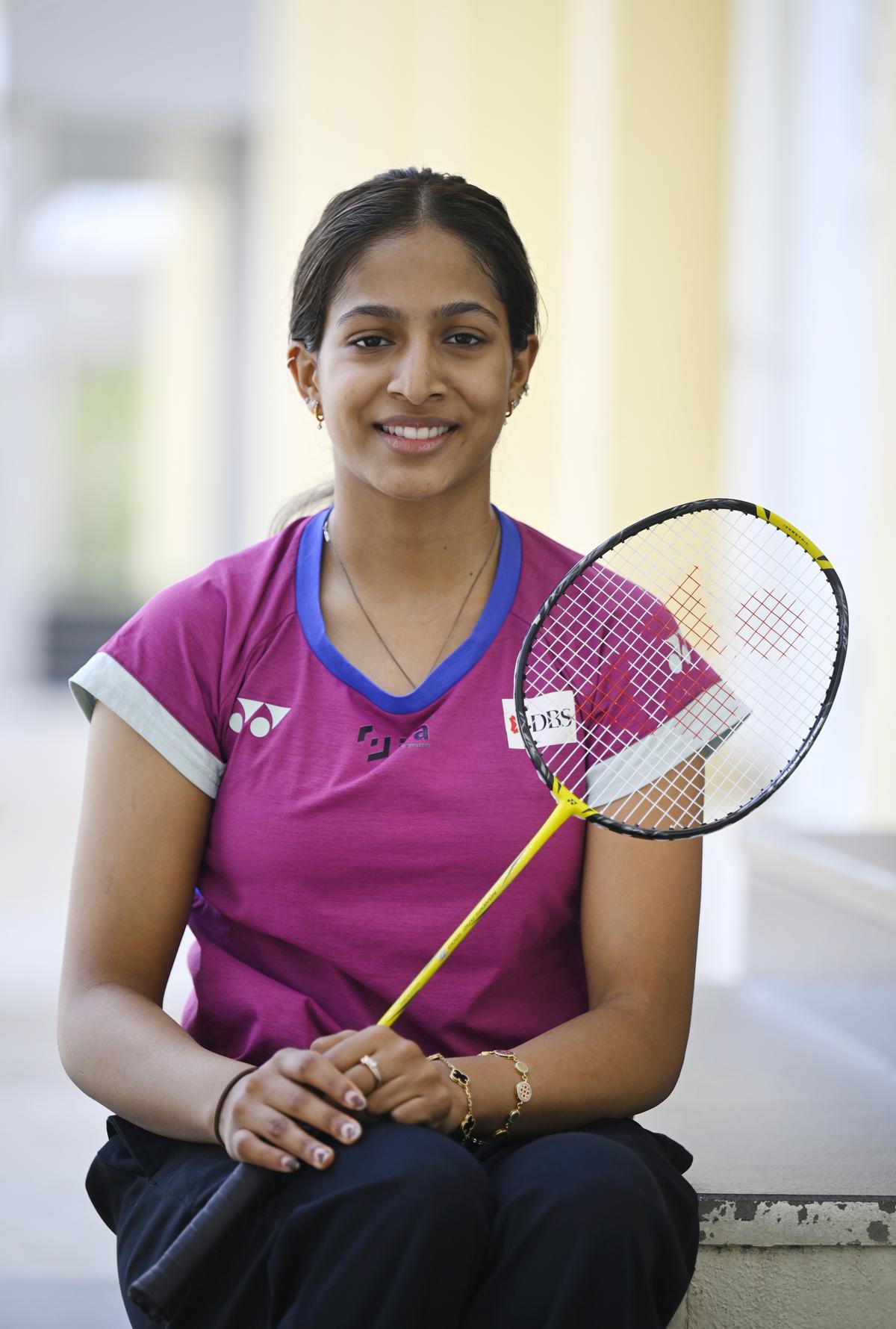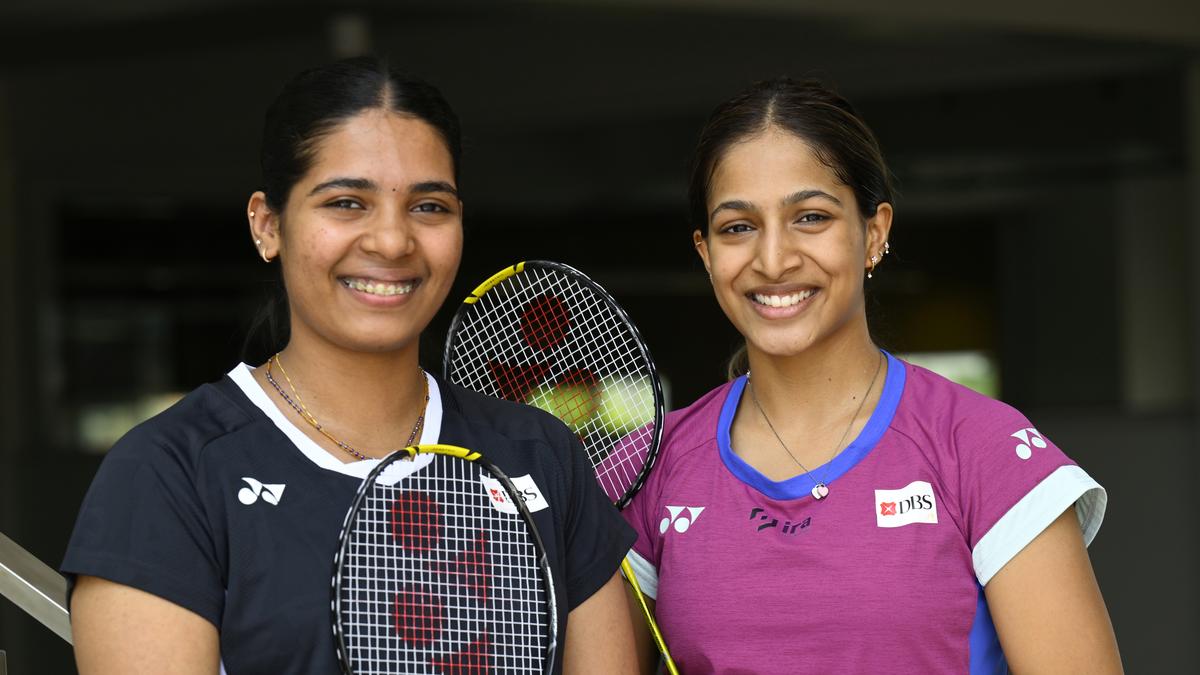The last Olympic cycle for Indian badminton was mainly about ‘Sat-Chi’ — the power-packed men’s doubles duo of Satwiksairaj Rankireddy and Chirag Shetty — and the dreams of an elusive gold.
At the same time, Treesa Jolly and Gayatri Gopichand or ‘TreGa’ were gradually learning the tricks of the trade in the demanding discipline of women’s doubles.
Hyderabad’s Gayatri (22), the daughter of Chief National Coach Pullela Gopichand, and Kannur’s Treesa (21) were predominantly singles players on the junior circuit before the coaches decided to pair them up in 2021.
The duo has been grinding in the shadows for the last four years — developing chemistry, chasing titles and ranking points, and tackling injuries.
With Treesa nursing a shoulder issue, the pair had to miss the Badminton Asia Championships (April 8-13) and will also skip the upcoming Sudirman Cup (April 27 – May 4).
But this time away from courts, something which elite athletes seldom get, has also provided the duo a chance to reflect on their journey so far.
In an interview at their training base — the Pullela Gopichand Badminton Academy in Hyderabad — the two shuttlers tell Sportstar about the learnings from missing out on Paris 2024, the battles with the top-ranked Chinese pair, and breaking new ground.

Gayatri Gopichand: We just have to support each other because in doubles, it happens. Your partner is not fit sometimes. As athletes, we get injured pretty often. We’ll get back stronger by the end of it.
| Photo Credit:
NAGARA GOPAL/THE HINDU
Gayatri Gopichand: We just have to support each other because in doubles, it happens. Your partner is not fit sometimes. As athletes, we get injured pretty often. We’ll get back stronger by the end of it.
| Photo Credit:
NAGARA GOPAL/THE HINDU
You’ve been playing together since 2021. How has your partnership evolved — on and off the court?
Gayatri: Earlier, I was playing singles, but I thought doubles would be best for me. So, I paired up with Treesa, and initially, in a few tournaments, it was great to see what it was like. Then we got into the All England Open (in 2022), which we never thought would happen. We performed well (reached semifinals), and that’s where we shone. Since then, it’s been a great journey. We’ve played some good matches with the top pairs, and I got to learn a lot.
Treesa: In 2021, we started to play together. That’s how I got to know Gayatri more, as in how she is. As a pair, we needed to share those moments. I am so grateful that, as a friend, off court also, she is so supportive. She is there if I need any help.
You won your first big tournament on the BWF World Tour circuit at the Syed Modi International in Lucknow last year.
Gayatri: It was the first time someone (Indian women’s pair) had won. I didn’t know that until we won the tournament. It’s a great feeling to win in the country. After winning the tournament, both of us were in tears.
Treesa: We always dreamt of winning such tournaments. Being on the podium and receiving that gold medal is a different feeling. The fans were calling us with different names. It was like a dream. It’s happiness that can’t be described.
You narrowly missed out on Paris, but time is on your side. What did you take away from your first Olympic cycle?
Gayatri: We missed out on the Paris Olympics, but that’s not the end. The LA Olympics 2028 is coming up. We didn’t lose heart. We kept training hard, just looking for opportunities in the next tournament. The Olympics is not the only important tournament. There are a lot more important events. It was heartbreaking to lose out on making it to the Olympics, but I feel more opportunities are coming our way.
Treesa: Like she said, we missed out on the Olympics, but we did train continuously. It was a little hard to believe that we didn’t qualify. But after that, the calendar was packed, and we started to play and perform from the next tournament.
And at the end of the year, we won the Syed Modi International. It’s the ‘never give up’ attitude.
You mentioned that the calendar is packed. Does that make it tough to rest and recover?
Treesa: We need to accept that the calendar is hard. We need to be very choosy about the tournaments we play. During the tournaments, we need to focus on our physical health and condition, and how we play and recover. It is not only for us. It is the same for everyone. That’s the reality we need to accept.
Treesa-Gayatri became the first-ever Indian women’s doubles pair to win the Syed Modi International, a BWF World Tour Super 300 event, last year.
| Photo Credit:
SANDEEP SAXENA/THE HINDU
Treesa-Gayatri became the first-ever Indian women’s doubles pair to win the Syed Modi International, a BWF World Tour Super 300 event, last year.
| Photo Credit:
SANDEEP SAXENA/THE HINDU
(To Treesa) How did you sustain your shoulder injury?
Treesa: The day after the All England Open pre-quarterfinals, it was hurting, and it was hard to play. Still, we continued to play the Swiss Open. We reached the semifinals, but it was getting hard for me to smash.
The physio said that I needed a break. We didn’t take a break from January to March. We played continuous tournaments. That’s why both of us decided to withdraw from the Asia Championships since it would be better for our health.
Gayatri: We just have to support each other because in doubles, it happens. Your partner is not fit sometimes. As athletes, we get injured pretty often. We’ll get back stronger by the end of it.
Women’s doubles is arguably the toughest among the five categories. The rallies can go up to 100-150 shots. How difficult is it to manage fitness?
Treesa: Physically, it is demanding. If it is a good match, it can easily go past 90 minutes. When we both started playing at that level, it was very difficult for us to play the rally games. But now, we are fighting with the Asian players and we have improved our strength in these four years.
Gayatri: Initially, it was a bit challenging. If we are playing against a top pair, it’s going to be 90 minutes at least. You can’t expect anything less. But we are giving them a fight at this point.
You’ve had close battles with World No. 1s Liu Sheng Shu and Tan Ning, even though they lead 6-1. What makes this matchup so compelling?
Gayatri: The first time we played against them at the Badminton Asia Mixed Team Championships in 2023, we beat them. After that, we’ve lost a few times. Even at the Swiss Open (semifinals) this year, we won the first set.
Both of us were confident that we could take the second set but it just didn’t go our way. Also, the Chinese pair has a different game compared to the usual women’s doubles. It is more like men’s doubles. They are more powerful as well.
Treesa: At the Swiss Open, we could have won that match. I think it was the best match we played. Almost 90 minutes. Strength-wise, we need to accept that they are better than us, but if we improve those small areas, we can beat them.
Which areas need improvement to beat top pairs such as Liu-Tan?
Treesa: Play-wise, we are equal to those pairs, but physically and mentally, we need to be stronger to get the crucial points.
You started your doubles journey under coach Arun Vishnu. Now, B. Sumeeth Reddy has become your coach.
Treesa: We have learnt a lot from both the coaches. When Arun bhaiya was there, we had just started. We began to compete internationally, which was new for us. Bit by bit, standing on the side, he helped both of us improve our game. Sumeeth bhaiya has just started to coach us, and I am so grateful that he is there for us.
In January (when they were ranked World No. 9), not only did you break into the Top 10, but you also went past the all-time highest ranking for an Indian women’s doubles pair, which earlier belonged to Jwala Gutta and Ashwini Ponnappa, who were World No. 10 at one point.
Treesa Jolly: We need to accept that the calendar is hard. We need to be very choosy about the tournaments we play. It is the same for everyone. That’s the reality we need to accept.
| Photo Credit:
NAGARA GOPAL
Treesa Jolly: We need to accept that the calendar is hard. We need to be very choosy about the tournaments we play. It is the same for everyone. That’s the reality we need to accept.
| Photo Credit:
NAGARA GOPAL
Gayatri: I definitely didn’t know that we crossed them in the rankings — that’s not something we were looking for. We were really happy to break into the top 10, and it’s just a nice feeling. It was overwhelming.
Treesa: When we played the World Tour Finals in 2024, that was the last time Arun bhaiya was our coach. He told us that India’s best women’s doubles ranking has been World No. 10. If you manage to go higher, it will become history.
You were the only Indian representatives at the BWF World Tour Finals in Hangzhou last year. Tell us about the experience of making your debut at the season-ending event.
Gayatri: We played against Liu-Tan in the first match. It was close. We won against the Malaysians (Pearly Tan and Thinaah Muralitharan). We were confident playing against the Japanese pair (Nami Matsuyama and Chiharu Shida) but it didn’t go our way. Even getting to contend against those pairs has been a great learning for us.
Treesa: I had always seen the players playing on the red mat on TV. I also wanted to play on the red mat. The stadium and the ambience were great. We played really good matches there and gained a lot of experience.
Tell us about the toughest environment you have faced during a tournament?
Treesa: Last year, we faced the Indonesians (Apriyani Rahayu and Siti Fadia Silva Ramadhanti) at the All England Open.
Obviously, wherever you go, the Indonesian fans will be there. The audience was shouting more than the players.
What are your goals for the rest of the season?
Gayatri: Being consistent is one of the main things for us. We’re on a break right now, but we’ll start playing at the Thailand Open (May 13-18) and Malaysia Masters (May 20-25). Of course, the World Championships (August 25-31) are coming up. So, I’m just looking forward to those tournaments.
In the last few years, the profile of doubles players has witnessed a significant rise.
Treesa: I’m so happy to see the change. If we play the top-level tournaments and reach the quarterfinals, we get so many messages which boost our confidence.
Gayatri: Satwik anna and Chirag are who I really looked up to when I was transitioning to doubles. They have been number one in the world.
That’s brought a huge change. After the matches, little kids are waiting for you to give autographs and say that they want to play doubles. It makes us really happy.

